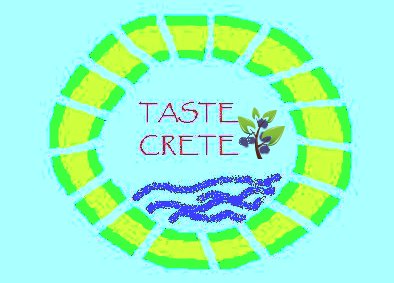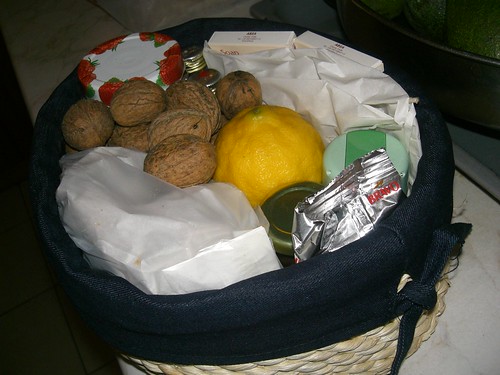Just before we get to London...
Cat Cora recently came to Hania and sampled our cuisine. A brief report was recently provided by a Cretan news site:
Cat Cora recently came to Hania and sampled our cuisine. A brief report was recently provided by a Cretan news site:
"Cat visited Chania for the first time, and after a short walk in the villages and downtown, she visited the Municipal Market and got impressed by the local traditional products and the authentic Cretan cuisine, such as kaltsounia with fennel, “lapathodolmades” and the local cheeses... She also promised that she will come back soon to Crete along with a group of chefs, to meet the food particularities of the place... It’s a good chance to inform the Americans about the Cretan diet and cuisine. The cuisine of Chania could even have its own brand name, such as cherry tomatoes from Santorini or the Lesbos ouzo”, she said."Here's a chance to market Cretan cuisine by a renowned American chef of Greek heritage. But hang on a minute: Isn't Cretan cuisine well known in the global food world? Well, I thought it was. Since the 1960s, the virtues of the Mediterranean diet have been expounded on the scientific, health and culinary world. There are also some PDO products being made, which are specifically known around Greece; Cretan cheese is represented in Greece by such PDO brands as Graviera and Xinomizithra, and there are also a variety of dishes which are specific to the region of Hania itself, such as boureki and xidato, so the cuisine of Hania already does have its own 'brand' name*.
The article also mentions Cat's introduction of the fusion cuisine term “Hellasian”, a rather unfortunate word used to denote the mixture of Greek and Asian cuisine: aside from the undesirable connotations of the first four letters of the word (horrify yourself by googling the search string!), the cuisine of a single country probably doesn't easily fuse with the cuisine of a whole continent. I don't think it will catch on too quickly.
But then, I am not a marketing expert, while Cat Cora is a celebrity chef in the USA, a country which supports culinary revolutions, culinary creations and culinary marketing. She could do for Greek (or Cretan) cuisine what we are not doing in our country and need to do in order to survive in the competitive world: she could use her fame to sell us, she could help us to win our market share.
What do people know about Crete? Probably our best known image is as a holiday destination for Northern European tourists: sun, sand and sea. And high quality fresh seasonal produce. Most people know about our olive oil (which sadly is not generally marketed as such, but by more generic names like "Greek" and, believe it or not, "Italian"), but very few other fresh Cretan products leave the country and make it on to the shelves of the countries where our tourists are from. The reasons for this are manifold, involving transportation costs, quantities grown/produced, the high cost demanded for such products, politics and the lack of a market image. But that's what living in the 21st century is all about - how to secure a share in the global market, so if we don't get this aspect under control, we will be in serious trouble (as if we aren't already).
One of the problems involved in marketing ourselves is a lack of substantive interest, knowledge of world markets and cooperation on the part of the producers. Small farms and local producers are not able to or are unwilling to compete at an international level; some are content to sell on the local market or to a wholesaler, and that's as far as they are prepared to go. They generally do not invest their earnings (or the subsidies they specifically received for this purpose) in their business, nor do they do further research into new market niches. I'd like to believe that this is changing, but sadly, it isn't. People are still trying to work independently, blindly believing in the sustainability of tradition, too blind to see the new traditions that are being created right before their very eyes (the traditional kafeneion is a good example). There are exceptions to the rule, but they are still too not on a large enough scale to make a difference.
Nevertheless, Crete is one place in the Mediterranean that produces, and has the potential to produce, a great variety of comestibles, so the lack of a Cretan profile in the global food market is an great hindrance in her advancement. We produce the goods, but lack the know-how to get them where they are most wanted. Tourist surveys conducted in Greece have found that tourists would like more information and access to Cretan produce; while we're swatting flies, Holland is considered the largest citrus fruit market in Europe (they don't produce any themselves, but centralise the goods in their own country where it gets re-distributed).
*** *** ***
If Mr P were to hire me to think up of an image of Crete to promote and advance Cretan produce, what would that image, which will eventually be encompassed in a logo, be? Whatever it is, it has to be instantly recognisable. The symbol of the shape of the island...
.
... is probably not a good one; only a true Crete-o-phile will be able to remember that one (otherwise, it looks like a distorted sausage). When my son was only four, he was able to locate the blimp that represented his island homeland on an A4-size world map, but that's his homeland, and it is a shape that carries some meaning for him. The more regional one gets map-wise, the less easy it is to recognise the area being shown in the wider sense, which is also why a map of the province of Hania:
as our global symbol is even more ludicrous. Most of us will know what the map of the UK looks like, but when asked to picture the map of Wales or Scotland alone, we probably couldn't do it.
So what do people know us by? An image of Crete that people can file away efficiently in their mind, which they can recall easily when they are presented with sensory experiences, would have to be one that reminds people of how they know us: we need a food icon, combined with the summer holiday ideas of sun and sea:
The sun and sea are portrayed by internationally recognisable symbols, while the olive twig with a few purple drupes hanging off it ** is a symbol often associated with oil-producing and/or Mediterranean countries, and one of the biggest producers of olive oil in Greece is Crete. The addition of the phrase 'TASTE CRETE' is the way I think those interested in consuming our products will remember their holiday. The taste of fresh Cretan produce encompasses the sun and sea factor: Cretan produce often 'smells' of sun (in its flavours) and sea (where tourists often consume their food when holidaying in Crete). The phrase is also brief, easy to remember, and gets to the point: by buying fresh Cretan produce, you will get another 'taste' of 'Crete', as you remember her during your vacation. From my own travel experiences, most Northern Europeans have a fair idea about where to find 'Kreta Paradise'; very many of them have come to Crete at one point in their lives on a two-week summer 'package holiday'.
If I had a chance to give someone a taste of Crete, what products would I choose from among my kitchen to pass on to them so that they can pack them in a suitcase and take them with them to their home country, where they would open the package, and the aromas and tastes of Crete would pop out? I recently had a chance to do this for Jo Holland, just before I set off for the cold North...
Due to weight, safety and size restrictions, I couldn't pack everything that I believe would have recreated a sense of that 'smell and taste' experience that I felt best represented Hania, but even then, I still managed to pack some fresh produce into that pretty basket, which Jo found particularly useful; maybe we shouldn't be too wary of Greeks bearing gifts after all, and the country of Greece can become known to produce something useful and sought after, unlike what we have been accused of lately (that we produce nothing and have nothing to export).
Mr P might like to consider how we can get our fresh products out of the country - they aren't perishable or difficult to transport as one might think, and they can tolerate transportation for a good number of days, so they will suffer less from our frequent strike action, road blockages and border closures!
The truth is that it all comes down to numbers in the end: there's few of us, and more of them. We will need to rely on those greater in number, those more organised than ourselves, those that are already well-equipped with the appropriate infrastructure, ready to deal with us, which they will do if we are willing to listen to them and start to prepare ourselves (is take up arms) for the fight for that bit of market share that we deserve.
To find out what was in the mystery parcel, Jo's post, and her fabulous photos - they make my food look better in her house in Blighty than they do in my own...
*Apologies to Cat Cora if she was being misreported. The article reports her interest in 'South American' cuisine, which was probably meant to be read as 'American South' or 'Southern American'. As a celebrity chef, however, she should be no stranger to researching the cuisine of any culture, so she could do a bit more homework before she visits a region, especially one she is herself a part of.
**That's what it is supposed to represent: it was the best I could come up with - I am still learning the ropes of online graphics programs!
©All Rights Reserved/Organically cooked. No part of this blog may be reproduced and/or copied by any means without prior consent from Maria Verivaki.


Food from Crete alone would not be well known here in Canada but most likely lumped together with Greek cuisine and products in general. I would be very hard pressed to find any ingredientts here in British Columbia that are only from this area and not found elsewhere as well.
ReplyDeletePrior to reading your blog, I knew of Crete mostly as a vacation destination. Your blog has been very educational in terms of describing the food, the culture and historical locations of Crete.
ReplyDeleteHere in Hawaii, the coffee and chocolate producers, among others, had to make a regional marketing play - i.e. Kona Coffee, to get an edge on the lower priced ones, (who pay less in wages). So, when tourists come, they look for Kona Coffee and Hawaiian made chocolates with macadamia nuts, etc.
ReplyDeleteKouklitsa Mou, So very proud of your blog!!!
ReplyDeleteWanted to pass along some PRAISE!
I'm a huge fan of your blog! I am about to celebrate 10,307 views of my blog, since 10 Dec 09. Couldn't do that without celebrating "with" you. Just wanted you to know I've "Tagged" your wonderful blog. Hard to resist a really good thing. It is featured on my "Serve Me Well", most recent posting, entitled, "What's love got to do with it? ... Food that is!"
I am a huge admirer of your blog, and your talent. Visit me if you get a chance, shall be a sincere pleasure!
Hope you like it!
Warmest regards,
Penelope
http://ptsaldari.posterous.com